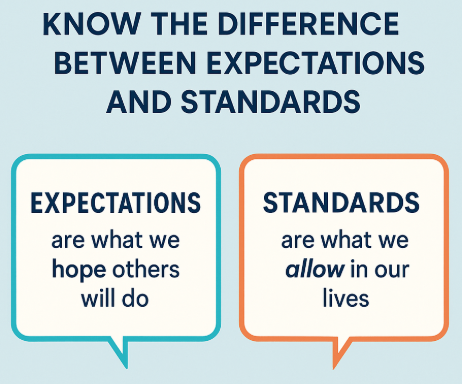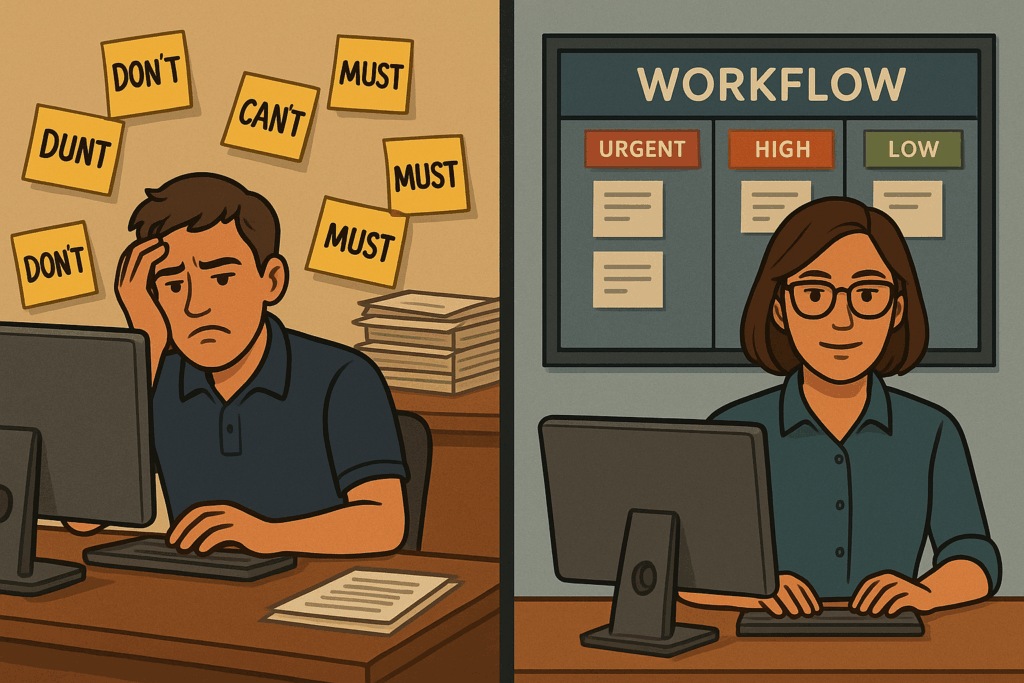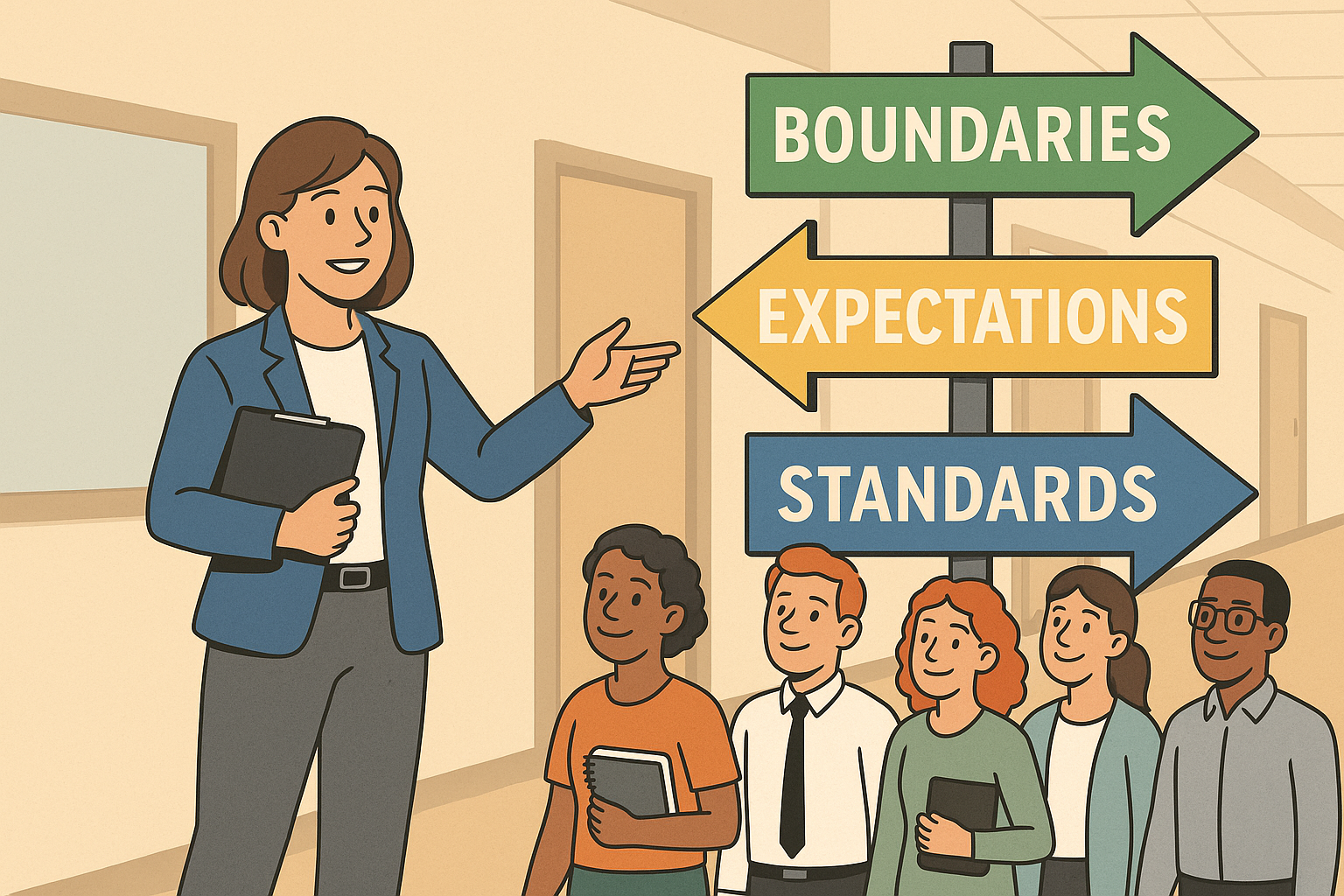
We’ve all said it in the break room or after a long day: “I just wish people would follow through.” Whether it’s responding to emails, honoring work hours, or showing up on time, leadership in education and technology roles comes with a steady stream of frustrations—and a quiet question behind them: Am I being clear enough?
I recently watched a short video by Dr. Raquel Martin that unpacked the difference between boundaries, expectations, standards, and rules. The distinctions were so sharp and practical that I couldn’t stop thinking about how they show up in our schools every day. Here are how these concepts apply directly to instructional coaches, campus leaders, and technology directors—and how we can use them to lead with more clarity, consistency, and kindness.
Start with Yourself: What Are You Actually Committed To?

Here’s the first distinction: a boundary is about your own behavior, not controlling others. In the video, one speaker said, “I don’t respond to texts after 10 p.m.” That’s a boundary. Saying, “You can’t text me after 10,” is a rule—and rules often fall apart unless you enforce them constantly.
For school leaders, this shift is crucial. Instead of declaring, “Teachers can’t email me on weekends,” try saying, “I don’t check or respond to work emails on weekends.” That small change reinforces what you control and models clarity for your team.
Try this approach:
- Reflect on three moments last week when you felt frustrated by someone’s behavior
- Ask: What boundary could I set around my own actions to reduce or prevent that frustration?
- Write it down in clear, neutral language focused on what you do or don’t do
Example: If your team expects instant replies to every message, you might say, “I check messages three times a day and respond within 24 hours.” That boundary sets a healthy norm without creating conflict.
Know the Difference Between Expectations and Standards

This distinction hit me hard: Expectations are what we hope others will do. Standards are what we allow in our lives.
Why Expectations and Standards Get Confused
As leaders, we often confuse these concepts. We might say, “I expect my team to arrive on time,” then feel quietly resentful when someone doesn’t. Standards help here. If punctuality matters, your standard might be: “I surround myself with people who respect time commitments.”
Why this matters: Expectations invite communication. Standards determine decisions.
Putting This Into Practice
Consider a team member who consistently misses deadlines. Your expectation might be, “I expect projects completed by agreed-upon dates.” Your standard could be, “I delegate critical tasks only to those who consistently meet deadlines.” That distinction protects your team’s momentum without constant confrontation.
Coaching strategy: When staff express frustration with others—students, colleagues, or parents—guide them through these questions:
- What do you expect?
- What is your standard?
- Are you communicating clearly?
- Do your actions align with your standards?
Replace Rules with Clearer Boundaries

Rules tend to emerge when we feel out of control: “You can’t… You must… You better not…” But that often backfires, especially in professional settings, creating power struggles instead of clarity.
Dr. Martin’s video suggests asking: “What am I trying to control?” If it’s someone else’s behavior, it’s probably a rule that won’t work.
A technology director might say something like, “Please try to resolve minor tech issues independently before submitting a help ticket.” Unsurprisingly, that probably won’t work well. A better approach is setting a boundary: “We respond to urgent issues first. Minor questions may take 48 hours.” This clarified workflow without sounding dismissive.
School and technology leaders can improve by:
- Auditing existing “rules” in handbooks, emails, or staff norms
- Rewriting behavior-policing language into boundaries that define workflow or expectations
- Modeling those boundaries consistently in your own communication
Use Clarity as a Form of Care

One of the most powerful insights from the video: “Clarity is kindness to others and yourself.”
Clear communication—not just loud communication—reduces stress, prevents passive-aggressive behavior, and builds cultures of mutual respect. Boundaries, expectations, and standards give us the vocabulary to achieve this.
The reality check: People can’t meet expectations they don’t understand. Staff can’t honor boundaries that shift weekly. Teams can’t uphold standards we never articulate.
Start small. Rewrite one confusing message. Have one honest conversation. Clarify one standard you’ve been letting slide. Then repeat next week.
💡 Common Pitfalls to Avoid
• Don’t confuse boundaries with ultimatums – Boundaries are about your behavior, not threats
• Standards aren’t about being judgmental – They’re about creating healthy professional environments
• Expectations without communication are just hopes – Make sure people understand what you’re hoping for
Quick Reference: See the Concepts in Action
Before diving into detailed examples, here’s a quick reference guide to help you recognize each concept:
| Concept | Technology Leadership Example | Coaching Example |
|---|---|---|
| Boundary | “I don’t provide tech support during lunch or prep periods.” | “I schedule coaching sessions only when I can be fully present.” |
| Expectation | “I hope teachers will try basic troubleshooting before submitting tickets.” | “I expect coaches to come prepared with specific questions.” |
| Standard | “I work with vendors who respond to urgent issues within 4 hours.” | “I partner with educators committed to student-centered growth.” |
| Rule | “All software installations must be approved by IT first.” | “Coaches cannot reschedule sessions without 24-hour notice.” |
Quick Quiz: Can You Tell the Difference?
Test your understanding with these scenarios. For each statement, decide if it’s an Expectation, Rule, Boundary, or Standard:
1. “You cannot use your phone during faculty meetings.”
2. “I hope teachers will submit lesson plans by Friday morning.”
3. “I only schedule important conversations when I can give my full attention.”
4. “I work with team members who communicate respectfully, even during disagreements.”
5. “Staff members must arrive 15 minutes before students.”
6. “I expect students to raise their hands before speaking.”
7. “I don’t engage in conversations about colleagues behind their backs.”
8. “Everyone needs to turn in their keys at the end of the year.”
9. “I surround myself with educators who are committed to continuous growth.”
10. “I’d like to see more collaboration between grade levels.”
Answers:
- Rule – Controls others’ behavior with “cannot”
- Expectation – Expresses hope about others’ actions
- Boundary – Defines your own behavior (“I only…”)
- Standard – Describes what you allow in your environment (“I work with…”)
- Rule – Mandates others’ behavior with “must”
- Expectation – States what you hope students will do
- Boundary – Personal commitment about your own behavior (“I don’t…”)
- Rule – Required action for others (“needs to”)
- Standard – Defines who you choose to have in your professional circle
- Expectation – Expresses desire for others’ behavior (“I’d like to see…”)
🎯 Key Takeaway
Clarity isn’t about being rigid—it’s about being kind. When you communicate boundaries, expectations, and standards clearly, you reduce confusion, prevent resentment, and create space for authentic professional relationships. The goal isn’t perfect compliance; it’s mutual understanding and respect.
Getting Started: Your Next Steps
Ready to put these concepts into practice? Here are three concrete actions you can take this week:
1. Audit Your Communication Review your last 5 emails to staff. Circle any language that sounds like rules (“you must,” “you can’t”) and rewrite them as boundaries or expectations.
2. Identify One Frustrating Situation Think of a recurring frustration with your team. Ask yourself: Is this about unclear expectations, a missing boundary, or a standard I’m not maintaining? Reframe it using the appropriate concept.
3. Practice the Language Before rolling out new communication approaches with your whole team, try the language with a trusted colleague. Get feedback on whether your boundaries, expectations, and standards come across as clear and respectful.
Bonus Resource: Download our Leadership Language Guide for a quick reference you can share with your team.
Your Turn: What Will You Try Next?
Which distinction feels most useful in your role? Is there a boundary, expectation, or standard you want to revisit this week?
Share your thoughts or tell us how you might use this language with your team. If you have examples or lessons learned, drop them in the comments—we learn better when we learn together.
Reflection question: How might clearer communication change the culture of your team? What would be different if everyone understood the distinction between what you expect, what you allow, and what you control?

